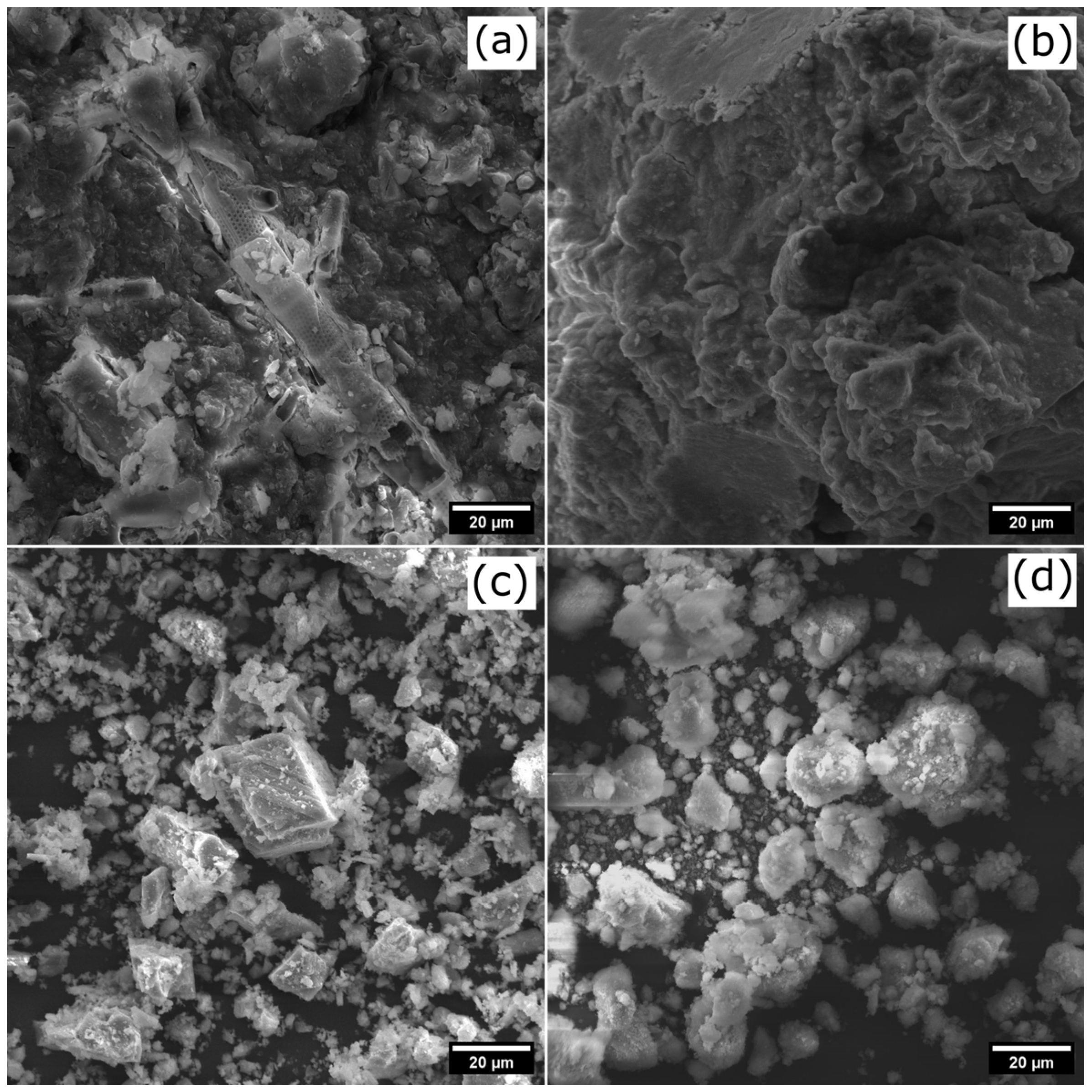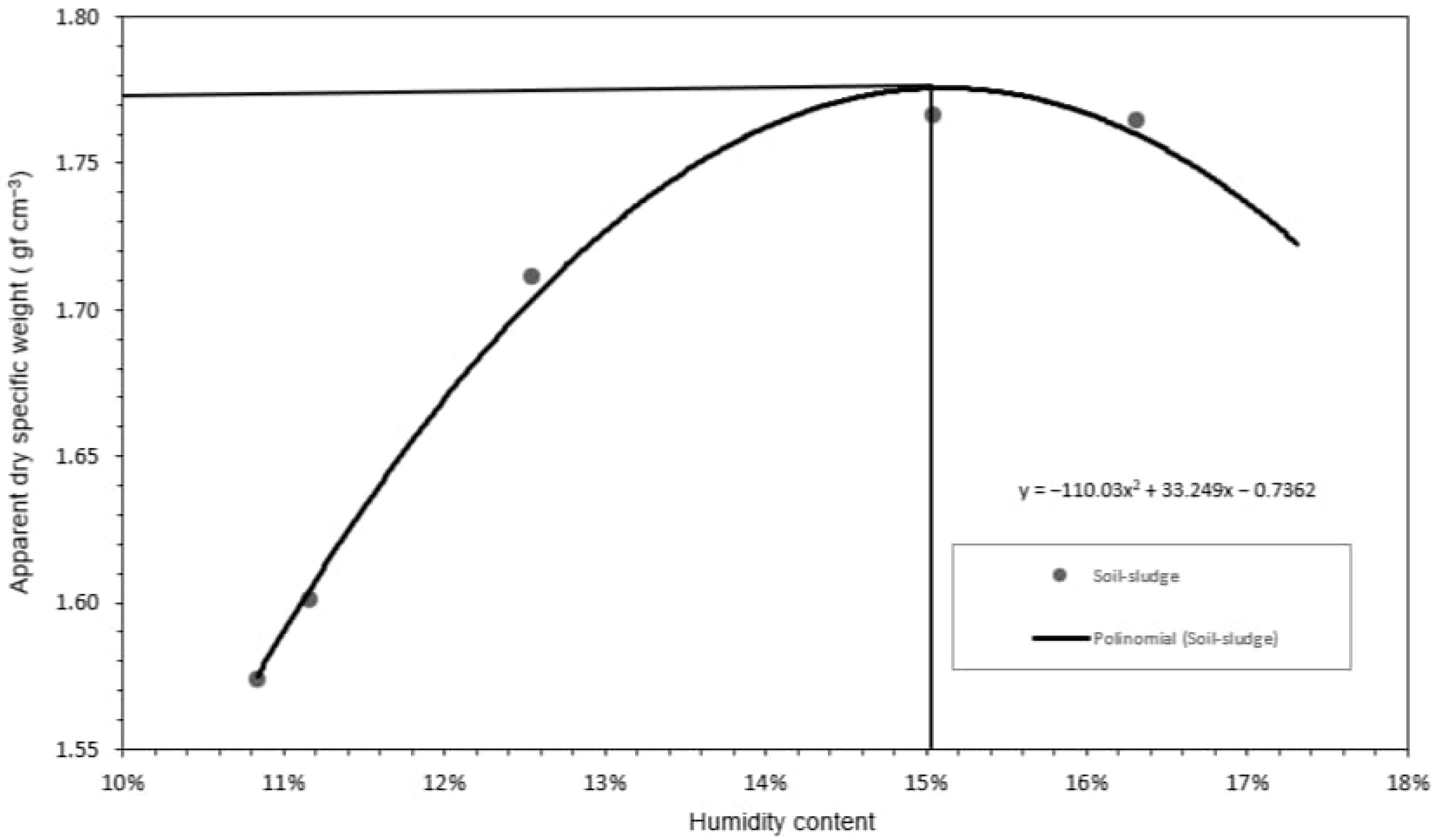Incorporation of Liquid WTP Sludge into Compacted Soil–Cement Mixtures
Abstract
:1. Introduction
2. Materials and Methods
2.1. Preparation of Materials for Mixing
2.2. Characterizations
2.2.1. Scanning Electron Microscopy (SEM) and Energy Dispersive Spectroscopy (EDS)
2.2.2. Soil Characterization
2.2.3. Soil Compaction Test with WTP Sludge
2.3. Molding of Cylindrical Test Specimens
2.4. Hydraulic Conductivity Test on Soil–WTP Sludge–Cement Mixture
Analysis of Leachate
2.5. Uniaxial Compression Test on Cylindrical Test Specimens
3. Results and Discussion
3.1. Scanning Electron Microscopy (SEM) and Energy Dispersive Spectroscopy (EDS)
3.2. Soil Characterization
3.3. Soil Compaction Test
3.4. Cylindrical Test Specimens with the Addition of Liquid WTP Sludge in the Mixture
3.5. Uniaxial Compression Test
3.6. Hydraulic Conductivity Test on Soil–WTP Sludge–Cement Mixture
Analysis of Leachate Obtained from the Permeability Test of the Mixture
4. Conclusions
- Incorporating WTP sludge into a compacted soil–cement mixture has proven to be a suitable disposal method for this waste, replacing water in the mix.
- The chemical characterization of WTP sludge about the materials identified atomic coincidences in the structural constituents of the materials.
- All selected mixes exhibited excellent strength to the applied load, on simple compressive strength, with the highest load supported being 8.63 MPa for mix ƴd3 (1.75 g cm−3).
- The determination of the permeability coefficient (k) showed that the mixture has low permeability properties, resulting in difficulties in water infiltration over time.
- The leached aluminum content appears promising in environmental terms, as its concentration was found to be below the maximum limit allowed by Brazilian technical standards.
Author Contributions
Funding
Data Availability Statement
Acknowledgments
Conflicts of Interest
References
- 46% da População Global Vive Sem Acesso a Saneamento Básico. ONU News. 2023. Available online: https://news.un.org/pt/story/2023/03/1811712 (accessed on 9 March 2024).
- Silva, A.M.d.S.; Barbosa, E.N.; Silva, M.F.d.C. Alternative use of water treatment plant sludge in paving: A review. Res. Soc. Dev. 2020, 9, e786974458. [Google Scholar] [CrossRef]
- ABNT NBR 10005; Procedimento Para Obtenção do Extrato Lixiviado de Resíduos Sólidos. Associação Brasileira de Normas Técnicas (ABNT): Rio de Janeiro, Brazil, 2004.
- ABNT NBR 8492; Tijolo de Solo-Cimento—Análise Dimensional, Determinação da Resistência à Compressão e da Absorção de água—Método de Ensaio. Associação Brasileira de Normas Técnicas (ABNT): Rio de Janeiro, Brazil, 2012.
- Nguyen, M.D.; Baghbani, A.; Alnedawi, A.; Ullah, S.; Kafle, B.; Thomas, M.; Moon, E.M.; Milne, N.A. Investigation on the suitability of aluminium-based water treatment sludge as a sustainable soil replacement for road construction. Transp. Eng. 2023, 12, 100175. [Google Scholar] [CrossRef]
- Detho, A.; Kadir, A.A.; Ahmad, S. Utilization of wastewater treatment sludge in the production of fired clay bricks: An approach towards sustainable development. Results Eng. 2024, 21, 101708. [Google Scholar] [CrossRef]
- ABNT NBR 6457; Amostras de Solo—Preparação Para Ensaios de Compactação e Ensaios de Caracterização. Associação Brasileira de Normas Técnicas (ABNT): Rio de Janeiro, Brazil, 2016.
- ABNT NBR 10833; Fabricação de Tijolo e Bloco de solo-Cimento Com Utilização de Prensa Manual ou Hidráulica—Procedimento. Associação Brasileira de Normas Técnicas (ABNT): Rio de Janeiro, Brazil, 2012.
- Limami, H.; Manssouri, I.; Cherkaoui, K.; Khaldoum, A. Recycled wastewater treatment plant sludge as a construction material additive to ecological lightweight earth bricks. Clean. Eng. Technol. 2021, 2, 100050. [Google Scholar] [CrossRef]
- ABNT NBR 6459; Solo—Determinação do Limite de Liquidez. Associação Brasileira de Normas Técnicas (ABNT): Rio de Janeiro, Brazil, 2016.
- ABNT NBR 7180; Solo—Determinação do Limite de Plasticidade. Associação Brasileira de Normas Técnicas (ABNT): Rio de Janeiro, Brazil, 2016.
- ABNT NBR 7182; Solo—Ensaio de Compactação. Associação Brasileira de Normas Técnicas (ABNT): Rio de Janeiro, Brazil, 2016.
- ABNT NBR 14545; Solo—Determinação do Coeficiente de Permeabilidade de Solos Argilosos à Carga Variável. Associação Brasileira de Normas Técnicas (ABNT): Rio de Janeiro, Brazil, 2021.
- Alexandre, E.; da Luz, C.A. Substituição parcial do cimento CPV-ARI por lodo de estação de tratamento de água (ETA). Rev. Matéria 2020, 25. [Google Scholar] [CrossRef]
- ABNT NBR 13600; Determinação do Teor de Matéria Orgânica por Queima a 400 °C. Associação Brasileira de Normas Técnicas (ABNT): Rio de Janeiro, Brazil, 2022.
- Anjum, T.; Khan, H.I.-H.; Tariq, W.; Farooq, U.; Shauket, I. Production of soil-cement bricks using sludge as a partial substitute. Earth Sci. Malays. ESMY 2017, 1, 10–12. [Google Scholar] [CrossRef]
- Caputo, H.P. Mecânica dos Solos e Suas Aplicações, 7th ed.; LTC: Rio de Janeiro, Brazil, 2015; 234p. [Google Scholar]
- Chalhoub, A.S.; Lourenço, E.S.d.O.; Filla, J.C.; Junior, E.F.; Madalozzo, I.L. Incorporação de lodo de ETA na fabricação de tijolos. In Proceedings of the 2° Congresso Sul-Americano de Resíduos Sólidos e Sustentabilidade—(CONRESOL), Foz do Iguaçu, PR, Brazil, 30 May 2019. [Google Scholar]
- Chikhi, M.; Balaska, F.; Boudraa, S.; Boutbiba, H.; Meniai, A.-H. Experimental study stabilization of sludge containing toxic metal by hidraulic binders. Energy Procedia 2012, 19, 259–268. [Google Scholar] [CrossRef]
- Gonçalves, G.; Lascosk, L.; Pietrobeli, J.M.T.A.; Lautenschläger, C.E.R.; Canteri, M.H.G.; Tusset, A.M. Influence of the Moisture Content and the dry specific weight on soil-cement-ash mixture. In Proceedings of the 11th World Congress of Chemical Engineering—(WCCE11), Buenos Aires, Argentina, 4–8 June 2023. [Google Scholar]
- Gomes, N.T.; da Silva, B.S.; Oliveira, G.d.S.; Alexandre, J. Análise do comportamento estrutural de corpos de prova de solo-cimento utilizando diferentes métodos de cura. Res. Soc. Dev. 2022, 11, e35511326570. [Google Scholar] [CrossRef]
- Chen, S.; Duan, P.; Zhao, M.; Shi, H.; Bie, Y. Solidification Mechanism and Strength Characteristics of Alkali-Activated Tannery Sludge–Slag Geopolymer. Buildings 2024, 14, 1060. [Google Scholar] [CrossRef]
- Prasittisopin, L.; Ferdous, W.; Kamchoom, V. Microplastics in construction and built environment. Dev. Built Environ. 2023, 15, 100188. [Google Scholar] [CrossRef]
- Silva, L.A.; Silva, F.d.S. Estudo da viabilidade de um solo para fabricação de tijolos de solo-cimento. Rev. FENEC 2019, 3, 82–89. [Google Scholar]
- Morselli, L.B.G.A.; Carmos, L.A.G.; Quadro, M.S.; Andreazza, R. Lodo de estação de tratamento de água: Possibilidade de aplicação no solo. Sci. Plena 2022, 18, 051701. [Google Scholar] [CrossRef]
- Roque, A.; Montalvan, E.L.T.; Boscov, M.E.G. Reuse of water treatment plant sludge mixed with lateritic soil in geotechnical works. Environ. Chall. 2020, 7, 100465. [Google Scholar]






| Atoms | WTP Sludge (%) | Soil (%) | Cement (%) | Test Specimen (%) |
|---|---|---|---|---|
| O | 53.4 | 35 | 72.6 | 68.8 |
| Si | 19.6 | 3.2 | 5.8 | 9.9 |
| Al | 18.4 | 4.0 | 1.3 | 1.1 |
| Fe | 5.2 | 1.8 | 0.9 | 2.0 |
| Ca | 0.1 | - | 35.2 | 3.7 |
| C | - | 64.8 | - | - |
| Sample | |
|---|---|
| Liquid limit (%) | 27 |
| Plastic limit (%) | 23 |
| Plasticity index (%) | 4 |
| Organic matter content in soil (%) | 5.45 |
| ƴd—Cement Content % | Mixture Proportions |
|---|---|
| ƴd1—1.65 gf cm−3 | Soil (g)—Sludge (g)—Cement (g) |
| ƴd1—7% | 331.42–47.42–24.94 |
| ƴd1—11% | 317.17–47.42–39.20 |
| ƴd1—14% | 306.48–47.42–49.89 |
| ƴd2—1.70 gf cm−3 | Soil (g)—Sludge (g)—Cement (g) |
| ƴd2—7% | 341.47–48.86–25.70 |
| ƴd2—11% | 326.78–48.86–40.38 |
| ƴd2—14% | 315.76–48.86–51.40 |
| ƴd3—1.75 gf cm−3 | Soil (g)—Sludge (g)—Cement (g) |
| ƴd3—7% | 351.51–50.29–26.45 |
| ƴd3—11% | 317.17–50.29–41.57 |
| ƴd3—14% | 306.48–50.29–52.91 |
| Data | |
|---|---|
| ƴd1 (gf cm−3) | 1.65 |
| ƴd2 (gf cm−3) | 1.70 |
| ƴd3 (gf cm−3) | 1.75 |
| h obtained (%) | 15 |
| Bulk Specific Gravity—Cement Content—Number of Test Specimens | Uniaxial Compressive Strength (MPa) |
|---|---|
| ƴd1-7-3 | 2.60 |
| ƴd1-11-3 | 3.65 |
| ƴd1-14-3 | 4.85 |
| ƴd2-7-3 | 3.68 |
| ƴd2-11-3 | 3.15 |
| ƴd2-14-3 | 5.40 |
| ƴd3-7-3 | 4.61 |
| ƴd3-11-3 | 8.75 |
| ƴd3-14-3 | 8.68 |
Disclaimer/Publisher’s Note: The statements, opinions and data contained in all publications are solely those of the individual author(s) and contributor(s) and not of MDPI and/or the editor(s). MDPI and/or the editor(s) disclaim responsibility for any injury to people or property resulting from any ideas, methods, instructions or products referred to in the content. |
© 2024 by the authors. Licensee MDPI, Basel, Switzerland. This article is an open access article distributed under the terms and conditions of the Creative Commons Attribution (CC BY) license (https://creativecommons.org/licenses/by/4.0/).
Share and Cite
Ribeiro, J.M.G.; Lautenschlager, C.E.R.; Santos, M.F.A.; Sabino, S.d.R.F.; Vieira, L.G.d.M.; Gonçalves, G.; Pietrobelli, J.M.T.d.A. Incorporation of Liquid WTP Sludge into Compacted Soil–Cement Mixtures. Processes 2024, 12, 1430. https://doi.org/10.3390/pr12071430
Ribeiro JMG, Lautenschlager CER, Santos MFA, Sabino SdRF, Vieira LGdM, Gonçalves G, Pietrobelli JMTdA. Incorporation of Liquid WTP Sludge into Compacted Soil–Cement Mixtures. Processes. 2024; 12(7):1430. https://doi.org/10.3390/pr12071430
Chicago/Turabian StyleRibeiro, Julio Marcos Gomes, Carlos Emmanuel Ribeiro Lautenschlager, Matheus Ferreira Alves Santos, Simone do Rocio Ferraz Sabino, Luiz Gustavo de Miranda Vieira, Giovanna Gonçalves, and Juliana Martins Teixeira de Abreu Pietrobelli. 2024. "Incorporation of Liquid WTP Sludge into Compacted Soil–Cement Mixtures" Processes 12, no. 7: 1430. https://doi.org/10.3390/pr12071430







